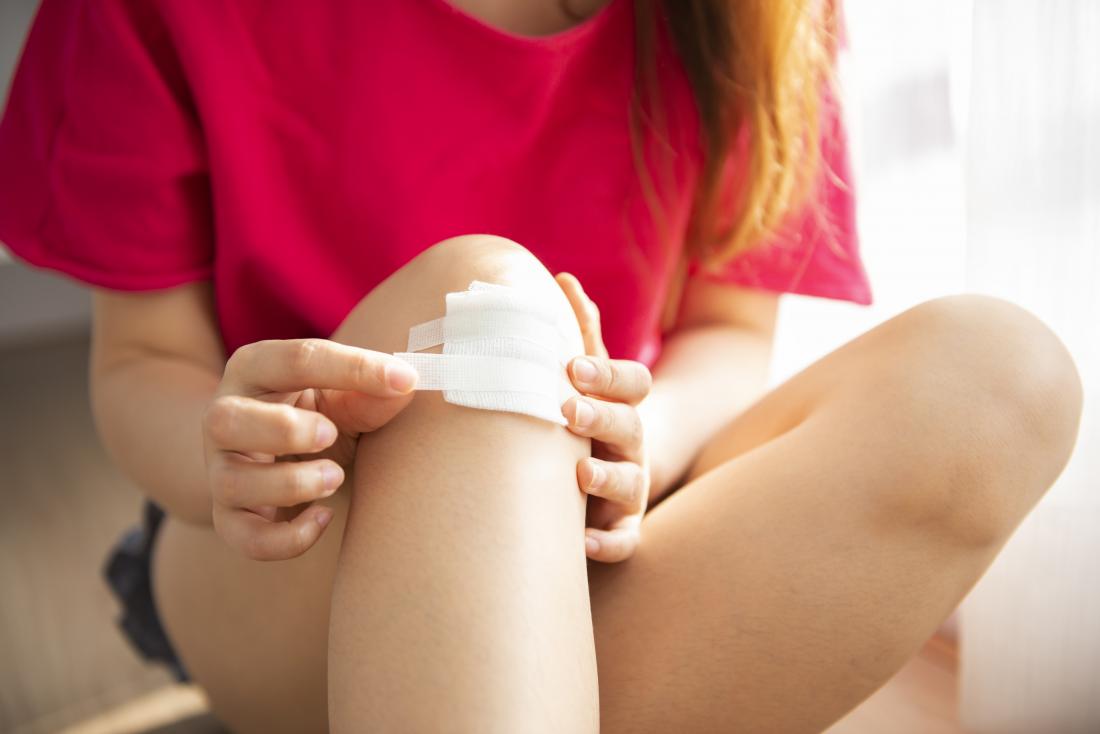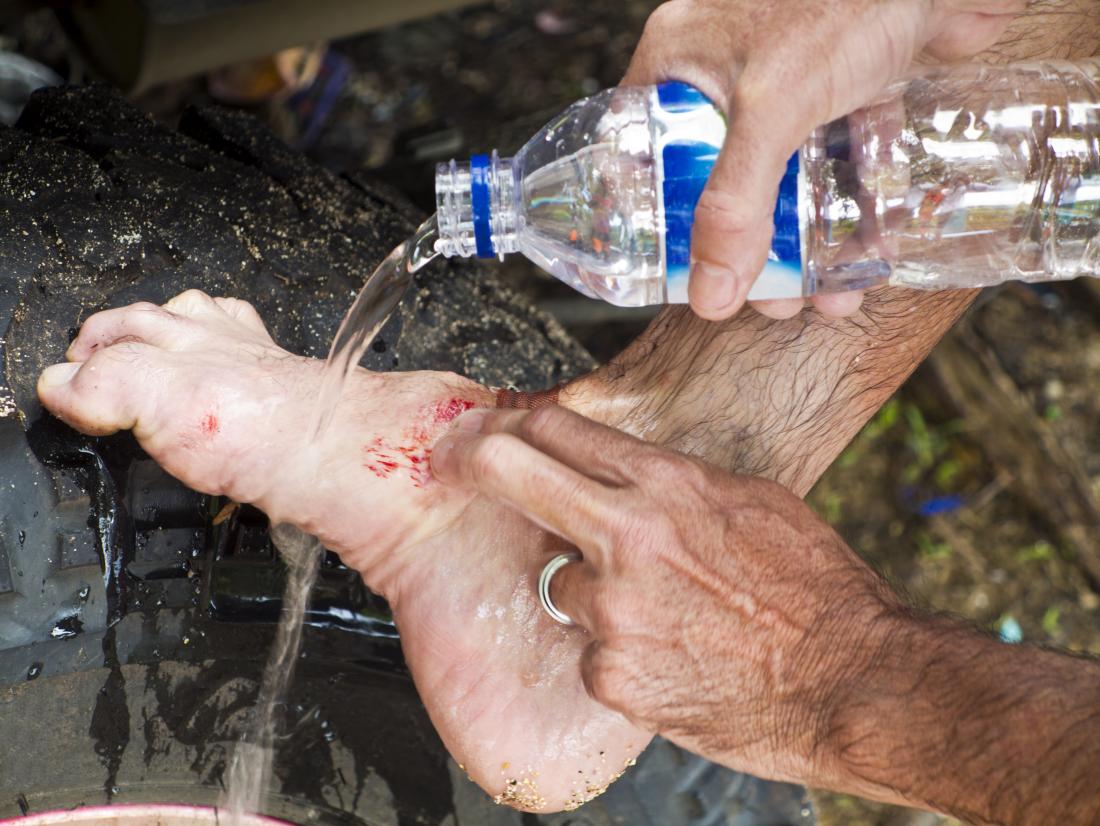How Do You Know When Your Cut Is Infected
A wound infection occurs when germs, such as bacteria, grow within the damaged pare of a wound. Symptoms can include increasing pain, swelling, and redness. More severe infections may cause nausea, chills, or fever.
A person may be able to treat pocket-size wound infections at home. However, people with more than severe or persistent wound infections should seek medical attention.
In this article, nosotros draw how to prevent, recognize, and care for an infected wound. We too cover adventure factors, complications, when to run into a doctor, and medical treatment.

A person with a pocket-size wound or infection tin can usually treat them at home.
People tin can usually safely care for small wounds, such as minor cuts and scratches, at home. With proper care, most small wounds volition gradually become improve until they fully heal.
If a wound becomes infected, however, it can get worse instead of amend. Any pain, redness, and swelling will typically increase in intensity.
Wound infections can also pb to other symptoms, such as:
- warm pare around the wound
- yellow or green discharge coming from the wound
- the wound giving off an unpleasant odor
- red streaks on the skin around the wound
- fever and chills
- aches and pains
- nausea
- vomiting
People with a mild infection of a small wound may exist able to treat the wound at habitation. However, more severe wound infections require prompt medical attention, particularly those that occur along with other symptoms, such equally fever, feeling unwell, or discharge and red streaks coming from the wound.
To treat an infected wound at home, follow these steps:
- Earlier beginning, ensure that all necessary equipment is make clean. For instance, if using tweezers, clean them with rubbing booze first.
- Thoroughly wash the hands with soap and warm h2o, so rinse and dry them.
- Clean the cutting or scrape past running warm water over it for several minutes. Use warm, soapy water to clean the surrounding skin, but avert getting soap in the wound.
- Make sure that there is no dirt or debris, such as glass or gravel, in the wound. To remove debris, either use tweezers or carefully and gently rub the wound with a soft, clammy cloth.
- If desired, apply a thin layer of antiseptic ointment or petroleum jelly to the cut or scrape.
- Allow the skin to air-dry before roofing it with gauze or a bandage. There is usually no need to comprehend minor cuts and scrapes.
Other tips for treating wounds at home include:
- Change the wound dressing at least in one case a 24-hour interval. Replace it immediately if it gets damp or dirty.
- Gently wash the wound each mean solar day.
- Avoid using hydrogen peroxide or iodine on the wound every bit these may cause skin irritation in some people. Stop using other antiseptic ointments if they crusade skin irritation.
- Do not pick at the peel or the scab as this can lead to scarring, deadening down healing, and increment the take a chance of infection.
- If the wound does non bear witness signs of improvement within 1–2 days, encounter a doctor.

A person should wash the wound immediately to prevent infection.
Cleaning and protecting a wound can reduce the risk of infection. Afterwards sustaining a modest cutting or scratch, a person should:
- Wash the wound immediately by running clean water over information technology for several minutes. So, clean the pare effectually the wound with warm, soapy water. If it is not possible to utilise clean water, care for the wound with booze wipes.
- Allow the skin to air-dry.
- Apply an antiseptic ointment to the wound.
- Protect the injury with gauze or another suitable dressing.
People with larger wounds or excessive haemorrhage will require medical handling. A healthcare professional tin can treat the injury to prevent infection and other complications.
People with animal bites or wounds from dirty or rusty objects may be at adventure of tetanus and should as well seek medical attending. A healthcare professional tin can clean the wound and give the person a shot to protect against tetanus infection if necessary.
Tetanus is a potentially fatal condition that occurs when certain bacteria enter the body and release toxins that affect the fretfulness. The symptoms of tetanus can include painful musculus spasms, lockjaw, and fever.
Cuts, grazes, and other breaks in the skin tin can go infected when bacteria enter the wound and begin to multiply. The bacteria may come up from the surrounding pare, the external surround, or the object that caused the injury.
It is important to make clean and protect the wound properly to reduce the risk of infection.
The hazard of wound infection is higher if:
- the wound is large, deep, or has a jagged border
- dirt or foreign particles entered the wound
- the crusade of the wound was a seize with teeth from an animal or some other person
- the cause of the wound was an injury involving a dirty, rusty, or contaminated object
Sure health conditions and environmental factors tin can likewise increase the adventure of infection. These include:
- diabetes
- poor blood apportionment
- a weakened immune organization, such as in people living with HIV or those taking immunosuppressant medications
- lack of mobility, for example, in people who spend nigh of their fourth dimension in bed
- advancing age — older adults are more at risk of wound infection
- nutrient and vitamin deficiencies
Rarely, incision wounds from surgical procedures tin can also become infected. According to the
If a person does not receive handling for a wound infection, it can spread to other parts of the body, which may lead to serious complications, including:
- Cellulitis is an infection of the deeper layers and tissues of the skin, and it can cause swelling, redness, and pain in the affected area. Other symptoms can include fever, dizziness, and nausea and airsickness.
- Osteomyelitis is a bacterial infection of the bone, and symptoms include pain, redness, and swelling around the infected area. Fatigue and fever are other symptoms that may affect those with osteomyelitis.
- Sepsis is an extreme immune reaction that can sometimes occur when an infection enters the bloodstream. Sepsis can pb to multiple organ failure and is life-threatening. According to the
CDC , nearly 270,000 people in the U.S. die each year due to sepsis. - Necrotizing fasciitis is a rare condition that occurs when a bacterial infection spreads into a tissue called the fascial lining that lies deep below the skin. Necrotizing fasciitis is a medical emergency that causes severe peel damage and pain and can spread throughout the body.
A person with a wound should seek medical attention if:
- the wound is large, deep, or has jagged edges
- the edges of the wound do not stay together
- symptoms of infection occur, such as fever, increasing hurting or redness, or discharge from the wound
- it is not possible to clean the wound properly or remove all debris, such as glass or gravel
- the cause of the wound was a bite or an injury from a dirty, rusty, or contaminated object
Seek urgent medical attending if claret is spurting from the wound or if applying pressure to the wound does not terminate the haemorrhage.

A doctor may treat an infection with antibiotics.
Doctors can treat a bacterial infection with antibiotics. It is important for a person to complete the course of antibiotics to treat the infection fully and to prevent the bacteria from becoming resistant to the drug.
In add-on to cleaning, some wounds may require further treatment. If the cutting is large or deep, for instance, a doctor or nurse may have to use stitches to shut it. They can often close smaller cuts with medical gum or strips of tape instead.
If the wound contains expressionless or contaminated tissue, a dr. may remove this tissue in a procedure called debridement. Debridement should promote healing and prevent the infection from spreading.
A person might require a tetanus shot if the cause of the wound was a bite or an injury from a muddy or rusty object.
The
A wound infection can occur if bacteria enter and multiply inside the wound. Immediately cleaning and dressing cuts, grazes, and other small wounds is the all-time style to forbid infections. Withal, people with larger, deeper, or more serious wounds should take a trained healthcare professional treat the injury.
The signs and symptoms of wound infection tin can include increasing pain, swelling, and redness around the affected area. A person may exist able to treat a mild infection of a small-scale wound at home past recleaning and redressing the wound.
Nevertheless, more severe wound infections require prompt medical attention, particularly those that occur along with fever, feeling unwell, or discharge and ruby streaks coming from the wound.
Read the article in Spanish.
Source: https://www.medicalnewstoday.com/articles/325040
0 Response to "How Do You Know When Your Cut Is Infected"
Post a Comment